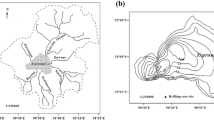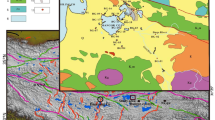Abstract
Dangxiong Co is a salt lake located in the center of the Tibetan Plateau, China. We studied the petrology, mineralogy, geochemistry and microfossil assemblages in the Quaternary, first terrace of Dangxiong Co. Limnocytherellina was the most common ostracode in the first terrace and prefers warm-humid conditions. Grainy ankerite in the terrace exhibits obvious overgrowth edges and uneven surfaces. Rare earth elements and Y distribution patterns in the first terrace show moderate rare earth enrichment, whereas Eu and Dy show weak negative and positive anomalies, respectively. These features indicate that the first terrace in Dangxiong Co is composed of lacustrine hydrothermal deposits. Moreover, the δ11B value of the Quaternary travertine is low, reflecting the low values in hydrothermal waters of the Quaternary. We suggest that hydrothermal water has been an important source of boron in the Quaternary. The three rivers on the south side of Dangxiong Co contribute 95% of the B2O3. The geochemical characteristics and the δ11B values of the waters in these three rivers are the same as in waters from Maerzuo hot spring. Thus, the hot spring is still the main source of boron to Dangxiong Co. These results have important implications for future exploration of borate deposits in salt lakes.





Similar content being viewed by others
References
Alonso R, Viramonte J (1985a) Geyseres boratíferos de la puna Argentina. IV Congreso Geológico Chileno, Actas, pp 23–44
Alonso R, Viramonte J (1985b) Provincia Boratífera Centroandina. IV Congreso Geológico Chileno, Actas, pp 45–63
Fan M, Yang L, Fang G, Wang M, Li T, Zhu L (2003) Origin of lacustrine hydrothermal sedimentary rock (Lower Cretaceous) in Qingxi Sag and its significance. Acta Sedimentol Sin 21:560–564 (in Chinese with English abstract)
Juske H (1990) Stable isotope paleoclimatology of brine inclusions in halite: modeling and application to Searles lake, California. Geochim Cosmochim Acta 54:2059–2073
Kitano Y, Okumura M, Idogaki M (1978) Coprecipitation of borate-boron with calcium carbonate. Geochem J 3:183–189
Lawrence H (2002) Borate formation in a perennial lacustrine setting: Miocene–Pliocene Furnace Creek Formation, Death Valley, California, USA. Sediment Geol 148:259–273
Li J, Sun D (1996) Boron isotopic geochemistry of Da Qaidan salt lake, Qaidam Basin, China. Geochimica 25:277–285 (in Chinese with English abstract)
Li Y, Zhang Q, Bingyuan L (1994) Ostracoda and its environmental significance at the ancient Tianshuihai Lake of the west Kunlun. J Lake Sci 49:46–54 (in Chinese with English abstract)
Ling Y, Sun Q, Zheng M, Wang H, Luo Y, Dai X, Xie M, Zhu Q (2017) Alkenone-based temperature and climate reconstruction during the last deglaciation at Lake Dangxiong Co, southwestern Tibetan Plateau. Quatern Int 443:58–69
Lü Y, Zheng M, Chen W, Zhang X, Liu X, Wu Q, Yu J (2013) Origin of boron in the Damxung Co Salt Lake (central Tibet): evidence from boron geochemistry and isotopes. Geochem J 47:513–523
Luo Y, Zheng M (2016) Origin of Boron in the Dangxiong Co Salt Lake, Tibet, China. Acta Geol Sin 90:1900–1907 (in Chinese with English abstract)
Palmer M, Spivack A, Edmond J (1987) Temperature and pH controls over isotopic fractionation during adsorption of boron on marine clay. Geochim Cosmochim Acta 51:2319–2323
Pang Q (1985) On a new ostracode genus from the Pleistocene in the pass of Kunlun mountain, Qinghai-Xizang (Tibet) plateau. Contribution to the Geology of the Qinghai-Xizang (Tibet) plateau, Qinghai-Xizang (Tibet) plateau. Contribution to the Geology of the Qinghai-Xizang (Tibet) plateau, Beijing (in Chinese with English abstract)
Pang Q, Zheng M, Liu W (1985) The late Cenozoic ostracoda of the Siling Lake and Bangkog Lake District in Xizang (Tibet) and its stratigraphic significance, Contribution to the Geology of the Qinghai-Xizang (Tibet) plateau, Beijing (in Chinese with English abstract)
Rosenthal Y, Lam P, Boyle EA, Thomson J (1995) Authigenic cadmium enrichments in suboxic sediments: precipitation and postdepositional mobility. Earth Planet Sc Lett 132:99–111
Smith G (1966) Geology of Searles Lake—a guide to prospecting for buried continental salines. In: 2nd symposium on salt, Cleveland, Ohio
Sun Q, Chu G, Liu G, Li S, Wang X (2007) Calibration of alkenone unsaturation index with growth temperature for a lacustrine species, Chrysotila lamellosa (Haptophyceae). Org geochem 38:1226–1234
Taylor SR, McLennan SM (1985) The continental crust: its composition and evolution. Blackwell, London
Tribovillard N, Algeo TJ, Lyons T, Riboulleau A (2006) Trace metals as paleoredox and paleoproductivity proxies: an update. Chem Geol 232:12–32
Vengosh A, Starinsky A, Kolodny Y, Chivas A, Raab M (1992) Boron isotope variations during fractional evaporation of sea water: new constraints on the marine vs. nonmarine debate. Geology 20:799–802
Vengosh A, Chivas A, Starinsky A, Kolodny Y, Baozhen Z, Pengxi Z (1995) Chemical and boron isotope compositions of non-marine brines from the Qaidam Basin, Qinghai, China. Chem Geol 120:135–154
Wen H (2008) Geochemical characteristics and origin of lacustrine hydrothermal sedimentation in Qingxi sag, Jiuquan Basin on the northern Tibetan Plateau. Chengdu University of Technology, Chengdu (in Chinese with English abstract)
Wen H, Zheng R, Fan M, Li Y, Gong B (2014) Primary dolostone related to the Cretaceous lacustrine hydrothermal sedimentation in Qingxi sag, Jiuquan Basin on the northern Tibetan Plateau. Sci China Earth Sci 4:003 (in Chinese with English abstract)
Wu Q, Zheng M, Nie Z, Bu L (2012) Natural evaporation and crystallization regularity of Dangxiong Cuo carbonate-type salt lake brine in Tibet. Chin J Inorg Chem 28:1895–1903 (in Chinese with English abstract)
Wu Q, Zheng M, Nie Z, Bu L (2013a) Experiment study of solar evaporation of brine from the Dangxiong Cuo salt lake in Tibet in winter. Acta Geol Sin 87:433–440 (in Chinese with English abstract)
Wu Q, Zheng M, Nie Z, Bu L (2013b) Scale-up study on potassium extraction from Dangxiong Cuo salt lake brine by evaporating ponds. Chin J Inorg Chem 29:36–44 (in Chinese with English abstract)
Xiao Y, Shirodkar P, Liu W, Wang Y, Jin L (1999) The investigation on isotopic geochemistry of boron in salt lake, Qaidam Basin, Qinghai. Prog Nat Sci 9:612–618
Yu J, Zheng M, Wu Q, Nie Z, Bu L (2015) Extracting lithium from Tibetan Dangxiong Tso Salt Lake of carbonate type by using geothermal salinity-gradient solar pond. Sol Energy 115:133–144
Zhang X, Zheng M, Chen W, Ye C, Luo Y, Kong W (2015) Some new opinions concerning the genesis of the lacustrine hydrothermal deposits in Wudaoliang Group, eastern Hoh Xil basin. Acta Geos Sin 36:507–512 (in Chinese with English abstract)
Acknowledgements
This research was supported by the China Geological Survey (Grant Nos. DD20190172, DD20190398 and DD20201115). The field work was supported by Dangxiongcuo Station for Salt Lake Resources and Environment Observation, Institute of Mineral Resources, Chinese Academy of Geological Sciences. The authors thank Dr. Kunli Luo, Institute of Geographic Sciences and Natural Resources Research, Chinese Academy of Sciences, for help with the ICP–MS and ICP–OES analyses, and Dr. Shifeng Dai, State Key Laboratory of Coal Resources and Safe Mining, China University of Mining & Technology, Beijing, for help with the XRD analysis.
Author information
Authors and Affiliations
Corresponding author
Rights and permissions
About this article
Cite this article
Luo, Y., Zheng, M., Ni, R. et al. The source of boron in Quaternary sediments of Dangxiong Co, Tibetan Plateau, China. J Paleolimnol 64, 167–178 (2020). https://doi.org/10.1007/s10933-020-00129-x
Received:
Accepted:
Published:
Issue Date:
DOI: https://doi.org/10.1007/s10933-020-00129-x




